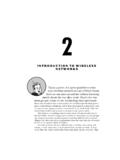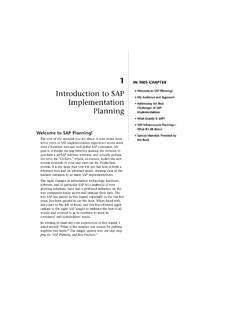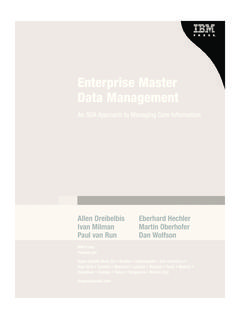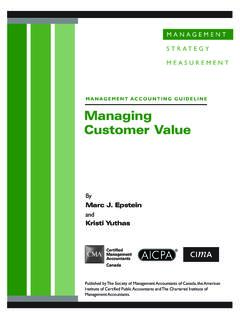Transcription of Chapter 9 Managing the customer lifecycle: customer ...
1 Chapter 9 Managing the customerlifecycle: customerretention anddevelopmentChapter objectivesBy the end of the Chapter , you will understand:1 what is meant by the term customer retention 2 the economics of customer retention3 how to select customers to target for retention4 the distinction between positive and negative customer retention5 several strategies for customer retention, including meeting and exceeding customerexpectations, finding new ways to add value , creating social and structural bonds, andbuilding emotional commitment6 the role of customer development7 why and how customers are sacked .IntroductionThis is the second of the three chapters that look at the critical issues ofprocess and structure for customer relationship management (CRM)implementation.
2 The core CRM processes are customer acquisition, customer retention and customer development. Together, they make upthe customer lifecycle. The processes of customer retention and develop-ment are the focus of this Chapter . customer acquisition is covered inChapter 8, and structure is covered in Chapter this Chapter you will learn about the important issues of customerretention and the customer lifecycle is the last primary stage of the CRMvalue chain (Fig. ).We propose that the major strategic role of CRM is to manage acompany s relationships with customers though three stages of thecustomer lifecycle: customer acquisition, customer retention and cus-tomer as a customer acquisition strategy aims to increase the number ofcustomers in the customer base, a customer retention strategy aims tokeep a high proportion of current customers by reducing customerdefections, and a customer development strategy aims to increase thevalue of those retained customers to the company.
3 Just as acquisition isfocused, so are retention and development. Not all customers are worthretaining and not all customers have potential for will deal with the issue of retention first, before turning customer Relationship ManagementSeveral important questions have to be answered when a companyputs together a customer retention plan. Which customers will be targeted for retention? What customer retention objectives should be set? What customer retention strategies will be used? How will the performance of the retention plan be measured?
4 These issues need to be carefully considered and programmed into aproperly resourced customer retention plan. Many companies, perhaps asmany as nine out of 10, have no customer retention plan in place. Asnoted in Chapter 8, most marketing plans fail to distinguish betweencustomer acquisition and customer retention. It is recommended thatcompanies think about these as separate, but related issues, and developappropriate is customer retention? customer retention is the strategic objective of striving to maintain long-term relationships with customers. customer retention is the mirrorimage of customer defection.
5 A high retention rate is equivalent to a lowdefection , customer retention is defined as:2the number of customers doing business with a firm at the end of afinancial year expressed as percentage of those who were activecustomers at the beginning of the , the appropriate interval over which retention rate should bemeasured is not always 1 year. Rather, it depends on the repurchase cycleFigure value chainManaging the customer lifecycle: customer retention and development 299found in the industry. Consider customer retention in an auto dealershipand an insurance broker. Insurance policies are renewed annually, unlikecars.
6 If the normal car replacement cycle is 4 years, then retention rate ismore meaningful if it is measured over 4 years instead of 12 companies are not clear about whether an individualcustomer has defected. The problems are created by the followingfactors. Product-based views of customers: consider insurance. Insurancecompanies often have product-based information systems. Effectively,they regard an insurance policy as a customer . If the policy is renewed,the customer remains active. However, take a customer who shopsaround for a better price and, after the policy has expired, returns tothe original insurer.
7 The insurer may take the new policy to mean anew customer has been gained. They would be wrong. Considerindustrial chemicals. A customer bought 500 tonnes of hydrogenperoxide last year. This year, owing to a change in manufacturingprocesses and products, the customer buys a different product andvolume, say 50 tonnes of magnesium peroxide. If the database is notsmart enough to detect and note the changed order, the supplier srecords may show this as a defected customer for hydrogen peroxideand a new customer for the magnesium product. Channel-based views of customers: telecoms companies acquirecustomers through many channels.
8 Consider a customer who buys a 12month mobile telecoms contract from a Vodafone-owned retail way through the year Vodafone launches a new pay-as-you-goproduct with no contractual obligation. The customer allows hercurrent contract to expire, then buys the new pay-as-you-go product,not from a Vodafone outlet but from a supermarket. Vodafone regardsher as a lost customer because the contract was not renewed. In thebusiness-to-business (B2B) market, office equipment dealers haveformed into buying groups to leverage better process and a customer stops buying direct from Brother Electronics andjoins a buying group, Brother s customer data may report a defection,but all that has happened is that the dealer has begun to buy througha different Multiple product ownership: a bank customer may have severalaccounts, such as current, savings and loan.
9 Consider a customer whopays off his debt and closes the loan account. The bank may considerthe customer to have defected because its customer data are held inproduct databases that are not integrated to give an overall view ofproduct ownership by the customer . A customer view would revealthat the customer is still active with current and savings defection is the mirror image of customer retention. If retentionis high, defection is low. The use of aggregates and averages in calculatingcustomer retention rates can mask a true understanding of retention anddefection. This is because customers differ in their sales, costs-to-serveand buying behaviours.
10 It is not unusual for a small number of customersto account for a large proportion of company revenue. If you have 100300 customer Relationship Managementcustomers and lose 10 in the course of a year, your raw defection rate is10 per cent. But what if these customers account for 25 per cent of yourcompany s sales? Is the true defection rate 25 per cent? Consideration ofprofit makes the computation more complex. If the 10 per cent ofcustomers that defected produce 50 per cent of your company s profits, isthe true defection rate 50 per cent?What happens if the 10 per cent lost customers are at the other end ofthe sales and profit spectrum?












